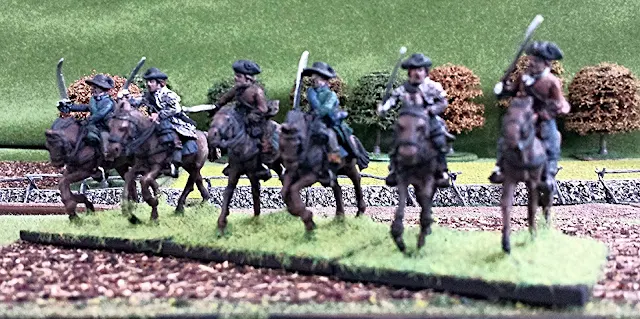Saturday, July 8, 2017
49th Regiment of Foot 1812
At the time war broke out, the 49th Regiment of foot was one of the only regiments of regulars in Canada. Having arrived in Canada in 1803 the regiment was stopped returning to Great Britian by the declaration of war.
Divided up into smaller commands the 49th was stationed around the Niagara area. The Grenadier and Light infantry companies were at Queenston Hieghts in October 1812 and played a prominent part in the battle. The regiment's commanding officer, Lietentant Colonel Isaac Brock (and commander of all British Forces in Canada) was killed at the head of the Grenadier and Light companies leading a charge against the Americans.
In November 11, 1813 at the Battle of Crysler's Farm the 49th and 89th regiments of foot fought and defeated a much larger American Army under General Boyd. It was a text book example of better trained and disciplined troops against poor quality but more numerous troops.
I have painted the regiment in its early war dress. Officers are still wearing bicorns with white breeches and the men stove pipe shakos. I really like the NCO's, keeping men on their toes and dressing the line. The gallant officer appears to be channeling General Brock inspiring his men. It is a nice break from the usual and gives the unit a dashing appearance.
Figures are from Knuckleduster miniatures. They continue to provide great figures and great value. The flags from Flags of War. These are a great item also and I wish they got more press and were better known as they are wonderful.
Wednesday, July 5, 2017
Captain James McCall's mounted militia 1780
Captain James McCall had been active an an officer in the South Carolina continental and militia forces. From 1776 to the end of the war he held various command and was almost always in the field leading soldiers. His service was typical of numerous militia leaders, with long years of service but little public credit.
His most memorial achievement was leading two troops of mounted militia. These were typical militia men who provided their own mounted and equipment. At the Battle of the Cowpens in January 1781 his men served with Ltd. Col. William Washington and played a dramatic part in the victory against Tarleton. He and his command continued to serve with the Continental cavalry of both Washington and Lee during the fighting in North Carolina. They left Greene's army just before Guilford Courthouse and returned to South Carolina where they fought under Pickens and Sumter's command.
Miniatures are from the Perry Brothers American Revolution line.
Tuesday, July 4, 2017
Monday, July 3, 2017
State line regiment 1781
Enjoyed painting the old RSM miniatures for regiment von Bose. So I wanted to paint some more. Here are the figures they sell which represent a generic Continental or British battalion. I painted it up in Brown coats faced red. One of my favorite patterns if early war uniforms, and also represented some of the French bounty coats sent in 1778. This regiment was to represent a state line regiment. It can be fielded on the table top as a continental line battalion, or a militia type battalion. As such it will fit in with my southern American Army. A most useful regiment!
Saturday, July 1, 2017
Sumter and Pickens
I have also done a couple command figures for my militia brigades. These represent Generals Sumter and Pickens. Both men were very different in command styles and personality. But both did an incredible amount to keep the rebellion alive at its darkest time in South Carolina.
Sumter, nicknamed "The Carolina Gamecock" was more dramatic and more impulsive. He gave as good as he got on the battlefield but at times was very easy with his men's lives. Pickens on the other hand cooperated with the continental officers better and was very protective of his men's lives. One friend said this taciturn individual was so silent he spoke only after he thought over what he would say and then took the words out of his mouth, examined them and then spoke.
They are very nicely done figures that painted up quickly. The hunting shirt wearing officer represents Sumter while Pickens is in his continental line uniform. Miniatures from Fife and Drum.
Subscribe to:
Comments (Atom)














